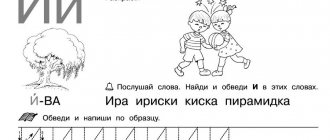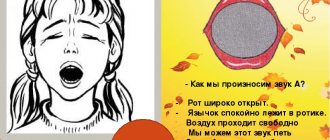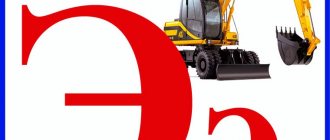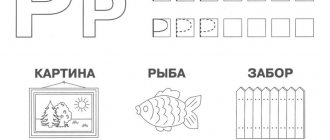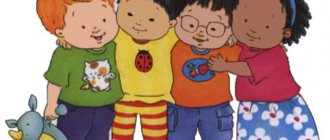Using tactile exercises
The child’s tactile sensations also need to be connected when learning the letter n. After all, these exercises activate the brain of a small person.
- Draw a symbol on the baby’s palm, ask the child to say its name – “en” with his eyes closed.
- Draw an “H” with your palms parallel to each other and your thumb placed perpendicular.
- Draw a symbol on a sheet of white paper with a finger dipped in watercolor paint or gouache.
- Make a letter from plasticine or salt dough and decorate the resulting figure.
- Draw the letter H with the crumbs' finger on the cereal, scattered in a thin layer on a horizontal surface.
Progress of the lesson
1. Organizational moment. Development of phonemic representations.
The teacher greets the children.
Teacher: The one who names the eye sounds
. Then consonants.
The children answer.
Teacher: Correct! Sit down. What sound do words end with?
: elephant, dream, clown.
Children's options.
Teacher: Correct. Today in class
we will get acquainted with a new
sound and the letter
N.
2. Sound [n]
.
Articulation of sound
.
Development of visual gnosis, constructive praxis
, fine motor skills, phonemic hearing. Cultivating a soft voice attack.
The teacher places a picture of a crying girl on the board.
Teacher. Look at the picture. The girl whines n-n-n. Repeat, Misha, how the girl whines.
Child. N-n-n!
Teacher. Let's pronounce the sound
“N”
, lips in a neutral position, the tip of the tongue raised and resting on the upper incisors.
When pronouncing the sound
N, vibration of the nasal cavity is felt.
What sound
?
Children. Consonant
Teacher How did you guess that this is a consonant sound
?
Children: Because you can draw it, but you can’t sing it.
Teacher: What color circle will we use to denote it?
Children: Blue circle
3. Game “Catch the Sound”
»
Development of phonemic hearing. Isolating the sound
[H] from a number of vowel
sounds
and syllables
Teacher: You need to catch the sound [n]
. When you hear it, clap your hands. N, t, p, m, n, o, a, n. Na, ma, an, un, pa, am, but.
4. Game “Determine the place of the sound in the word”
»
Teacher. Listen to the poem and name words that begin with the sound [n]
.
Natasha has a freckled nose.
Our Nata is a first-grader.
Children. nose, Natasha, ours, Nata.
P a g o g Well done! You have heard all the words that begin with the vowel sound [n]
.
The teacher displays diagrams indicating the place of sound in a word
.
Teacher Next task. You need to determine where the sound
[n] in each of these words.
Looking at pictures that have the sound [n]
, and determining the place
of sound in a word
: thread, lemon, glass, drum, rhinoceros, night.
Teacher: Well done, you did a good job.
5. Introducing the letter N
.
Development of visual gnosis and constructive praxis
.
The teacher places a three-dimensional letter H
.
Teacher Leg, leg
A belt was placed across it.
Letter letters
“H” with a finger in the air.
How many sticks does it take to make the letter H?
?
Children: Three
Teacher Well done! You folded the letter N
, and now put the sticks in containers.
See how you can make the letter H
. Try this too.
The teacher removes the containers.
P a g o g Look at the letters H on the board
. One is big and the other is small.
6. Exercise “Find pictures”
. Development of visual perception, phonemic representations.
The teacher posts a picture.
TEACHER And now let's find on this page objects whose names also begin with this sound N
.
Children. Socks, thread, knife, scissors.
P a g o g Look at the flowers. These are narcissists. Repeat this word.
Children. Daffodils.
P a g o g What sound
does this word begin?
Children. From sound [N]
.
7. Exercise “Let’s read”
. Formation of reading skills.
P a g o g Now let's read the syllables and words.
Children, first in chorus, and then one by one, read the syllables, and then the words.
8. Physical education break.
9. Work in a notebook. Development of fine motor skills, graphomotor skills. The teacher invites children to tables, hands them open notebooks and containers with pencils.
Peda g o g What letter
do you see on the leaves?
Children. This is the letter N
.
P food g o g What pencil will you color it with?
Children. Blue.
Teacher Why?
Children. This is a consonant
.
P a g o g Color the large letter with a blue pencil
, and
first circle the small letter
and then color it.
The children complete the task, the teacher watches how they sit, how their notebooks are laid out, how they hold their pencils.
P a g o g What pictures do you see on this page?
Children. We see threads.
11 e d a g o g From what sound
do their names begin?
Children. From the sound [n]
.
11. Organization of the end of the lesson
. Assessment of children's work.
The teacher invites the children to remember what they did in class
.
Pe d a g o g With which letter
did you meet today?
Children. With the letter N
.
Pe d a g o g What letter
?
Children of Solasnaya.
P a g o g How many sticks do you need to take to form the letter N
?
D s t i. Three sticks.
Pedagogy What words starting with the sound [n] do you remember
?
Pedagogy What we did in class
?
Publications on the topic:
Summary of a subgroup speech therapy lesson on literacy in accordance with the Federal State Educational Standard “Sound [U] and the letter U” Summary of a subgroup speech therapy lesson. Type of lesson: training. Group of children according to the structure of speech impairment: FFNR Age:.
Summary of a literacy lesson for children of the preparatory group “Sound [O] and letter O” Objectives: Repetition of learned vowels, differentiating them from each other. Updating children's knowledge about the letter O. Consolidating the visual image.
Summary of a literacy lesson for children of the preparatory group “Sound [U] and the letter U” Purpose: Generalization of knowledge about the sound and letter U. Develop the ability to distinguish the vowel sound U from a number of other sounds, from words. ; selection of words for a given one.
Summary of the literacy lesson “Sound [ts]. Letter C” Objectives of the lesson: to introduce children to the letter C, teach them to read words with this letter; to form the skills of spelling correctly, express.
Summary of the literacy lesson “Sound [h]. Letter Ch. Combinations cha, chu” Objectives of the lesson: to introduce children to the letter Ch, combinations CHA, CHU, to teach how to read words and combinations correctly; develop spelling skills.
Purpose of the lesson: we study the letter N, the formation of reading skills, the development of speech skills, the improvement of phonemic awareness, the basics of elementary graphic skills.
- introduce the preschooler to the letter N and the correct pronunciation of the sound;
- teach how to write the printed letter N in squares;
- to generate interest in learning poems and riddles.
They bought little Natasha a toy horse. Natasha sat on the horse and shouted: “But-but-but!”
- How did Natasha scream?
- NNNO - what is the first sound here?
- Who bought the horse?
- NATASHA - what is the first sound in this word?
Name what is shown in the pictures below:
Scissors Sky Notes Rhinoceros
What is the first sound in the word RHINO? - SCISSORS? Is the [n] sound in the word LEMON at the beginning, at the end or in the middle of a word? WINDOW? RAM? NOTES?
When we pronounce the sound [n], the tip of the tongue hits the “tubercles” behind the upper teeth. Say: NNN. The tip of the tongue hits the “tubercles” behind the upper teeth and prevents air from freely leaving the mouth when we pronounce the sound [n].
- Vowel or consonant sound [n]?
- What other consonant sounds do you know?
- Voiced or unvoiced sound [n]?
- What other voiced consonant sound do you know? ([m])
